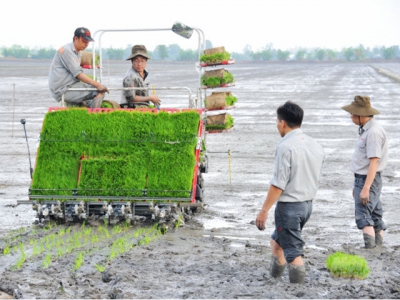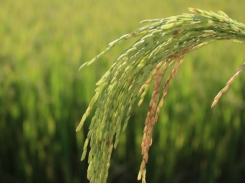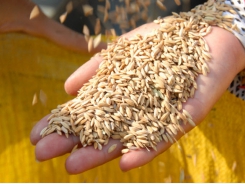Farmers encouraged to plant autumn-winter crops in dyke-protected regions

Farmers in An Giang are advised to plant inside 699 protected dyke subregions to ensure that the sown area has 100% flood control embankments.
An Giang farmers are focusing on sowing seeds for the autumn-winter rice crop in 2021. Photo: Le Hoang Vu.
According to Nguyen Sy Lam, head of the An Giang Department of Agriculture and Rural Development, the province lies upstream, which means that the autumn-winter rice crop production is often susceptible to flooding, which used to inflict considerable damage. As a consequence, the agricultural sector is advising farmers to plant inside 699 protected dike subregions to achieve 100% flood control embankments totaling 160.957 hectares.
According to Lam, agriculture is collaborating with local governments to firmly direct autumn-winter seed planting according to the required time frame and notice of sowing to prevent hoppers. Sowing should not take place more than seven months apart in the same subregion.
Each crop will not be sown for more than two months to ensure that damage caused by brown planthoppers, yellow dwarf disease - leaf twisting, rice stem gall midge, and other pests and diseases are kept to a minimum.
In autumn-winter rice production, agriculture advises farmers to use integrated pest management techniques such as IPM, "three decreases, three increases," and "one must, five reduce," and to limit seed planting to 80-100 kg per ha, rather than 150-180 kg per ha as before.
Additionally, paying close attention to adopting water-saving irrigation methods, encouraging the adoption of ecological technology, and the model of "rice field with flower bank" to attract natural enemies to reduce pesticide usage in the field. Within the first 40 days after planting, improve communication and educate farmers on pesticide usage following the "4 right" principle.
Simultaneously, strengthening measures to assist rice plants in remaining healthy, such as micronutrient supplements, calcium, and silicon fertilizers, and others, to assist rice plants in increasing their natural resistance, combined with regular field inspections to detect pests early and guide farmers in handling pests and taking timely response measures.
Related news
Tools

Phối trộn thức ăn chăn nuôi

Pha dung dịch thủy canh

Định mức cho tôm ăn

Phối trộn phân bón NPK

Xác định tỷ lệ tôm sống

Chuyển đổi đơn vị phân bón

Xác định công suất sục khí

Chuyển đổi đơn vị tôm

Tính diện tích nhà kính

Tính thể tích ao



 Summer-autumn rice consumption in Mekong Delta provinces facing…
Summer-autumn rice consumption in Mekong Delta provinces facing…  Floating rice: the unique rice variety with internodes…
Floating rice: the unique rice variety with internodes…